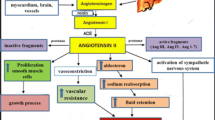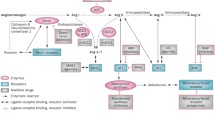Abstract
The renin-angiotensin system (RAS) is well recognized for its importance in regulation of BP, electrolyte balance and vascular growth. Pharmacological suppression of the RAS, through ACE inhibition and/or angiotensin receptor blockade, is a proven effective therapeutic approach to the treatment of a range of cardiovascular diseases. Renin is the enzyme that catalyzes the first and rate-limiting step of RAS, the cleavage of angiotensinogen to angiotensin I (A-I). A-I is then further converted by ACE to the biologically active vasoconstrictor, A-II.
Interruption of the generation of A-II by renin inhibitors at this highly specific initial step of the cascade would be expected to have similar but not identical effects to those of the already well established RAS antagonists. Due to the lack of effective alternative enzyme pathways, blockade of A-II production may be more effective with renin inhibition than with ACE inhibition, and because of the high specificity of renin for only one substrate, namely angiotensinogen, adverse effects would be expected to be less frequent. It is currently unclear whether blockade of angiotensin II type 1 receptors (AT1), leaving other A-II receptors unblocked, is preferable to the reduction in plasma and tissue A-II levels achieved with either ACE or renin inhibition.
The development of early peptidic and peptidomimetic renin inhibitors was hampered by problems with oral bioavailability and high costs of synthesis. However recent work has led to the synthesis of a potent non-peptidic inhibitor of renin, aliskiren, which has acceptable oral bioavailability. This renin inhibitor has been shown to effectively reduce A-II levels in normal volunteers and to lower BP in patients with mild to moderate hypertension. It appears likely that aliskiren is the first of a new class of agents that may prove useful in the management of patients with nephropathy, heart failure and atherosclerosis in addition to hypertension.
Similar content being viewed by others
References
Tigerstedt R, Bergman PG. Niere und Kreislauf. Skand Arch Physiol 1898; 8: 223–71
Braun-Menedez E, Fasciolo JC, Leloir LF, et al. La substancia hipertenora de la sangre del rinon isquemiado. Rev Soc Argent Biol 1939; 15: 420–30
Page IH, Helmer OM. A crystalline pressor substance (angiotonin) resulting from the reaction between renin and renin activator. J Exp Med 1940; 71: 29–42
Skeggs Jr LT, Marsh WH, Kahn JR, et al. The existence of two forms of hypertension. J Exp Med 1954; 99: 275–82
Laragh JH, Angers M, Kelly WG, et al. Hypotensive agents and pressor substances: the effect of epinephrine, norepinephrine, angiotensin II and others on the secretory rate of aldosterone in man. JAMA 1960; 174: 234–40
Oparil S, Haber E. The renin-angiotensin system. N Engl J Med 1974; 291: 381–401/446–57
Dzau VJ. Tissue angiotensin and pathobiology of vascular disease, a unifying hypothesis. Hypertension 2001; 37: 1047–52
Beta Blocker Heart Attack Trial Research Group. A randomised trial of propranolol in patients with acute myocardial infarction: mortality results. JAMA 1982; 247: 1707–14
Campbell DJ, Aggarwal A, Esler M, et al. Beta-blockers, angiotensin II, and ACE inhibitors in patients with heart failure. Lancet 2001 Nov 10; 358(9293): 1609–10
SOLVD Investigators. Effect of enalapril on survival in patients with reduced left ventricular ejection fractions and congestive heart failure. N Engl J Med 1991; 325: 293–302
Cohn JN, Tognoni G. A randomized trial of the angiotensin-receptor blocker valsartan in chronic heart failure. N Engl J Med 2001; 345: 1667–75
Pitt B, Zannad F, Remme WJ, et al. The effect of spironolactone on morbidity and mortality in patients with severe heart failure: randomized aldactone evaluation study investigators. N Engl J Med 1999; 341: 709–17
Giatras I, Lau J, Levey AS. Effect of angiotensin-converting enzyme inhibitors on the progression of nondiabetic renal disease: a meta-analysis of randomized trials. Angiotensin-Converting-Enzyme Inhibition and Progressive Renal Disease Study Group. Ann Intern Med 1997; 127: 337–45
Bjorck S, Mulec H, Johnsen SA, et al. Contrasting effects of enalapril and metoprolol on proteinuria in diabetic nephropathy. BMJ 1990; 300: 904–7
Bjorck S, Mulec H, Johnsen SA, et al. Renal protective effect of enalapril in diabetic nephropathy. BMJ 1992; 304: 339–43
Brenner BM, Cooper ME, de Zeeuw D, et al. RENAAL Study Investigators. Effects of losartan on renal and cardiovascular outcomes in patients with type 2 diabetes and nephropathy. N Engl J Med 2001; 345: 861–9
Lewis EJ, Hunsicker LG, Clarke WR, et al. the Collaborative Study Group. Renoprotective effect of the angiotensin-receptor antagonist irbesartan in patients with nephropathy due to type 2 diabetes. N Engl J Med 2001; 345: 851–60
Yusuf S, Sleight P, Pogue J, et al. Effects of an angiotensin converting enzyme inhibitor, ramipril, on cardiovascular events in high-risk patients: the Heart Outcomes Prevention Evaluation Study Investigators. N Engl J Med 2000; 342: 145–53
Dahlof B, Devereux RB, Kjeldsen SE, et al. for the LIFE Study Group. Cardiovascular morbidity an mortality in the Losartan Intervention For Endpoint reduction in hypertension study (LIFE): a randomised trial against atenolol. Lancet 2002; 359: 995–1003
Brunner HR, Laragh JH, Baer L, et al. Essential hypertension: renin and aldosterone, heart attack and stroke. N Engl J Med 1972; 286: 441–9
Weber MA, Neutel JM, Essinger I, et al. Assessment of renin dependency of hypertension with a dipeptide renin inhibitor. Circulation 1990; 81: 1768–74
Neutel JM, Luther RR, Boger RS, et al. Immediate blood pressure effects of the renin inhibitor enalkiren and the angiotensin-converting enzyme inhibitor enalaprilat. Am Heart J 1991; 122: 1094–00
van den Meiracker AH, Admiraal PJJ, Derkx FHM, et al. Comparison of blood pressure and angiotensin responses to the renin inhibitor RO 42-5892 and the angiotensin converting enzyme inhibitor enalapril in essential hypertension. J Hypertens 1993; 11: 831–8
Kobrin I, Viskoper RJ, Laszt A, et al. Effects of an orally active renin inhibitor, Ro 42-5892, in patients with essential hypertension. Am J Hypertens 1993; 6: 349–58
Hollenberg NK, Fisher NDL. Renal circulation and blockade of the renin-angiotensin system: is angiotensin converting enzyme the last word? Hypertension 1995; 26: 602–9
Fisher ND, Hollenberg NK. Is there a future for renin inhibitors? Expert Opin Investig Drugs 2001; 10: 417–26
Rahuel J, Rasetti V, Maibaum J, et al. Structure-based drug design: the discovery of novel non peptide orally active inhibitors of human renin. Chem Biol 2000; 7: 493–504
Nussberger J, Wuerzner G, Jensen C, et al. Angiotensin II suppression in humans by the orally active renin inhibitor aliskiren (SPP100): comparison with enalapril. Hypertension 2002; 39: e1–8
Stanton AV, Jensen C, Mann J, et al. BP lowering with SPP 100: a novel orally active renin inhibitor — a pilot study [abstract]. Hypertension 2001; 38: 526, P202
Stanton A, Barton J, Jensen C, et al. Dose response antihypertensive efficacy of aliskiren (SPP 100), an orally active rennin inhibitor [abstract]. AJH 2002; 15 (Pt 2): 56A
Barlucchi L, Leri A, Dostal DE, et al. Canine ventricular myocytes possess a reninangiotensin system that is upregulated with heart failure. Circ Res 2001; 88: 298–304
Re R. The nature of intracrine peptide hormone action. Hypertension 1999; 34: 534–8
Wolny A, Clozel JP, Rein J, et al. Functional and biochemical analysis of angiotensin II-forming pathways in the human heart. Circ Res 1997; 80: 219–27
El-Amrani A-IK, Menard J, Gonzales MF, et al. Effects of blocking the angiotensin II receptor, converting enzyme and renin activity on the renal haemodynamics of normotensive guinea pigs. J Cardiovasc Pharmacol 1993; 22: 231–9
Hollenberg NK, Fisher Fisher NDL. Renal circulation and blockade of the reninangiotensin system. Hypertension 1995; 26: 602–9
Phillips MI, Speakman EA, Kimura B. Levels of angiotensin and molecular biology of the tissue renin angiotensin systems. Regul Pept 1993; 43: 1–20
Fisher NDL, Allan D, Kifor I, et al. Responses to converting enzyme and renin inhibition: role of angiotensin II in humans. Hypertension 1994; 23: 44–51
Sunman W, Sever PS. Non-angiotensin effects of angiotensin-converting enzyme inhibitors. Clin Sci 1993; 85: 661–70
Burnier M. Angiotensin II type 1 receptor blockers. Circulation 2001; 103: 904–12
Swanson GN, Harding JW. Discovery of a distinct binding site for angio (3–8), a putative AT4 receptor. Regul Pept 1993; 40: 409–19
Kerins DM, Hao Q, Vaughan DE. Angiotensin induction of PAI-1 expression in endothelial cells is mediated by the hexapeptide Angiotensin IV. J Clin Invest 1995; 96: 2515–20
Lithell H, Hansson L, Skoog I, et al. The Study on Cognition and Prognosis in the Elderly (SCOPE): principal results of a randomized double-blind intervention trial. J Hyperten 2003; 21(5): 875–86
PROGRESS Collaborative Group. Randomized trial of a perindopril-based blood-pressure-lowering regimen among 6105 individuals with previous stroke or transient ischaemic attack. Lancet 2001; 358: 1033–41
Dickstein K, Kjekshus J. OPTIMAAL Steering Committee of the OPTIMAAL Study Group. Effects of losartan and captopril on mortality and morbidity in high-risk patients after acute myocardial infarction: the OPTIMAAL randomised trial. Lancet 2002 Sep 7; 360(9335): 752–60
Yusuf S. From the HOPE to the ONTARGET and the TRANSCEND studies: challenges in improving prognosis. Am J Cardiol 2002; 89(2A): 18A–25A
DelliPizzi AM, Hilchey SD, Bell-Quilley CP. Natriuretic action of angio (1–7). Br J Pharmacol 1994; 111: 1–3
Li P, Chappell MC, Ferrario CM, et al. Angiotensin (1–7) augments bradykinininduced vasodilation by competing with ACE and releasing nitric oxide. Hypertension 1997; 29: 394–400
Freeman EJ, Chisolm GM, Ferrario CM, et al. Angiotensin-(1–7) inhibits vascular smooth muscle growth. Hypertension 1996; 28: 104–8
Loot AE, Roks AJM, Henning RH, et al. Angiotensin-(1–7) attenuates the development of heart failure after myocardial infarction in rats. Circulation 2002; 105: 1548–50
Mahon JM, Carr RD, Nicol AK, et al. Angiotensin (1–7) is an antagonist at the type 1 angiotensin II receptor. J Hypertens 1994; 12: 1377–81
Brosnihan KB, Li P, Ferrario CM. Angiotensin-(1–7) dilates canine coronary arteries through kinins and nitric oxide. Hypertension 1996; 27: 523–8
Chappell MC, Pirro NT, Sykes A, et al. Metabolism of angiotensin-(1–7) by angiotensin converting enzyme. Hypertension 1998; 31 (1 pt 2): 362–7
Luque M, Martin P, Martell N, et al. Effects of captopril related to increased levels of prostacyclin and angiotensin-(1–7) in essential hypertension. J Hypertens 1996; 14: 799–805
Iyer SN, Chappell MC, Averill DB, et al. Vasodepressor actions of angiotensin-(1–7) unmasked during combined treatment with lisinopril and losartan. Hypertension 1998; 31: 699–705
Yusuf S, Reddy S, Ôunpuu S, et al. Global burden of cardiovascular diseases. Circulation 2001; 104: 2746–53
Joint National Committee on Prevention, Detection, Evaluation and Treatment of High BP. The sixth report of the Joint National Committee on Prevention, Detection, Evaluation and Treatment of High BP. Arch Intern Med 1997; 157: 2413–46
EUROASPIRE Study Group. EUROASPIRE. A European Society of Cardiology survey on secondary prevention of coronary heart disease: principal results. Eur Heart J 1997; 18: 1569–82
Author information
Authors and Affiliations
Corresponding author
Rights and permissions
About this article
Cite this article
Stanton, A. Therapeutic Potential of Renin Inhibitors in the Management of Cardiovascular Disorders. Am J Cardiovasc Drugs 3, 389–394 (2003). https://doi.org/10.2165/00129784-200303060-00002
Published:
Issue Date:
DOI: https://doi.org/10.2165/00129784-200303060-00002




